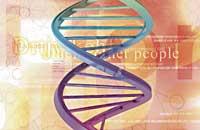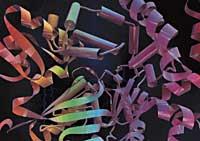DNA garbage or something similar

What is garbage in biology? What does not have value? It is difficult to say. And that is why biologists do not always approach. For example, if they do not find the function of an organ, they deduce that it serves no purpose. And they call it garbage. The same has happened in the investigation of the human genome. When they started working they expected to find about one hundred thousand genes, but when they finished the search they only found twenty-five thousand. Twenty-five thousand!
A room of what they expected! Biochemists knew that this was going to happen because the genome has gaps. However, the low number of genes hinders the interpretation of data. So, where seventy-five thousand genes had to be, what is there?

It is clear that there is no. DNA is a long molecule that stores information in data sequences. In these sequences are encoded all the proteins that the body needs. But not all sequences are followed, as if between the chapters of a book there were meaningless pages and within the text groups of senseless letters.
In books there is usually no. But in the genome yes. And this part of the genome, that is, those DNA sequences that do not encode proteins, was called DNA from garbage (translation of the English term Junk DNA).
The book's metaphor has been widely used to explain the human genome. The metaphor is clear, but not everything explains. It is true that both the book and the genome are supports that keep information. And it is true that the information is organized in both sequences (writing, we would say). But what happens to junk DNA? That's the limit of the book's metaphor: the genome has a part that supposedly does not encode information, which in a book would be a nonsense.

The problem is that it is not clear if that junk DNA serves something. It does not encode proteins, but is it garbage or not? No one knows it, but today there are many biochemists who question themselves.
In favor and against
The logical thing is to analyze the arguments in favor and against (and continue investigating all the options, of course). But it seems that in the discussions among biochemists the arguments contrary to the fact that this fragment of DNA is considered junk are taking force. It is a diffuse zone, because there is still not much data, but, according to many speculations, it does not seem that garbage can be called to what we do not understand. However, first of all, we will begin with arguments in favor of your consideration as garbage.
There are reasons to say that a part of DNA does not serve at all. To understand these reasons, one must look at evolution. If the gaps without DNA information are garbage, why did evolution there? The question is that evolution is not a conscious author, who does not do things according to a goal.


With the passage of time some characteristics of living beings develop and others are lost. The same occurs with genes. The genome of a living being is added new genes (or new groups of genes) and others disappear. But these processes are not automatic. They are not planned. And above all (it is worth repeating), they do not work with a goal.
Therefore, it is legitimate to think that some fragments of DNA that have been left without function still remain in the genome. They may disappear later. However, with so few data it is possible to think otherwise.
Then it will be necessary to explain what this piece of DNA serves (do not forget that it is a large, very large part). Biochemicals have launched a series of hypotheses among which one is being imposed.
To understand this hypothesis, one must take into account the appearance of DNA. DNA is a helical molecule. But to some extent it is like the circular cable of the phone. Who does not know that the phone cable tends to twist? It winds over itself. That is, in addition to having a helix shape, it is wound over and over again on itself.

If while we speak by phone we play with the cable, the cable is more rounded. After four or five calls, the cable is completely confused. It is almost impossible to stretch the cable. If the phone cable were longer, the mixture would be inliberable.
The same is true of the DNA molecule. It is wound on his head (and on some supports). The result seems chaotic, but the structure is ordered. It is X-shaped and is called chromosome.
Thus, it seems very difficult to find a data inside the chromosome. Where is each gene? And where to start? It is possible that the function of this garbage DNA is to organize this mixture. Why not? If the DNA does not, it is achieved in another way. If not, the cell would not function properly.
Unfortunately we do not know if this hypothesis is correct. It is unknown if this junk DNA serves to organize the chromosome. And although it's worth, we don't know how it does. But at least it is worth analyzing it.
One gene, three proteins
Genes have encoded the information necessary to produce proteins. When the cell needs a certain protein, it searches for that gene on the chromosomes and makes a copy of the information. The copy reaches the ribosomes and the ribosomes make the protein.

As explained, it seems that a gene keeps the information of a single protein, but biochemicals have seen that in a gene there is an average of three proteins. How is it possible?
The copy of the information (called messenger RNA) is modified before reaching the ribosomes. Among other things, “empty” are removed without information and the code is adapted.
This process can be done by the cell in various forms. Depending on how the process is performed, a protein or other is formed. Therefore, a gene does not have the information of a single protein, but of an average of three.
Remove and remove Calling garbage a piece of genome seems very brave. The original term in English is the word junk, and many experts find it excessive. The truth is that this jun and the word garbage in Basque do not express the same thing. In English it is about worthless things that accumulate without wanting jun. Detail, junk DNA is a very dark concept. Those who practice genetics also do not know what their function is, or if they have it. For this reason, it is to be appreciated that genetic manipulation is still in the first steps. Yes you can make a genetic manipulation, but there are still great difficulties, for example, to change the genes to a living being. If this is achieved, many genetic diseases could be cured, but it would also have its negative side. Using these procedures, the residual DNA of the genome could be removed. In medicine there are other cases. If the appendix becomes infected and painful, the patient is removed by a simple intervention. It is shown that removing the appendix is no serious problem. Something similar happens with friends. In case of disease, if they give problems they are eliminated. The last ones are also a good example. Sometimes, even being healthy, they leave to avoid future problems. Is it possible that genetics go the same way? It can be speculated. In the future, a laboratory may decide to create a human being using a minimum genetic code. Why not? It can replace cloning. You can only produce strictly necessary proteins without adding anything that is junk. Can it be terrible and if DNA garbage is not garbage? Fortunately, genetics have a long way before deciding to remove junk DNA. In addition, almost certainly biochemists will learn a lot in this way. And when they study, we could resume this same article and laugh at what is written. Perhaps that day is not so far away. |





